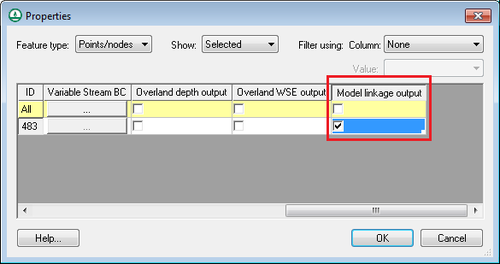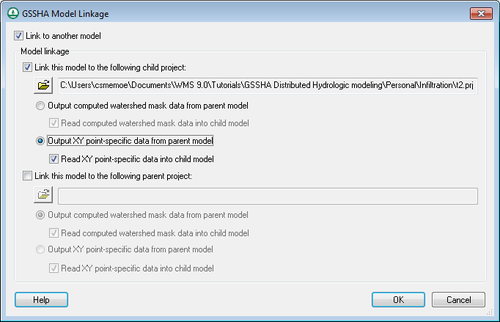WMS:GSSHA Model Linkage: Difference between revisions
No edit summary |
No edit summary |
||
| Line 1: | Line 1: | ||
The ''GSSHA Model Linkage'' dialog, accessible from the ''GSSHA Job Control'' dialog, allows | The ''GSSHA Model Linkage'' dialog, accessible from the ''GSSHA Job Control'' dialog, allows the user to link link to current GSSHA model to other GSSHA models. If there is a parent (regional) model in the WMS interface and the user wants to link this parent model to a child (inset) model, select the options shown below: | ||
:[[Image:GsshaInsetModelLinkToChildMask.png|thumb|none|left|500 px|GSSHA Inset model dialog, showing the option to link the existing model to a child model]] | :[[Image:GsshaInsetModelLinkToChildMask.png|thumb|none|left|500 px|''GSSHA Inset model'' dialog, showing the option to link the existing model to a child model]] | ||
Note that if these options are selected, WMS writes the appropriate cards to both the parent model and the child model, using the child model’s mask file as the output mask, so the boundary data is output from the parent model and is read into the child model. | Note that if these options are selected, WMS writes the appropriate cards to both the parent model and the child model, using the child model’s mask file as the output mask, so the boundary data is output from the parent model and is read into the child model. | ||
If | If wanting to output data from the parent model at specific XY points, the user would define the point locations in the GSSHA coverage in the map module and mark these locations as ''Model linkage output'' points in the ''GSSHA point properties'' dialog, as shown below: | ||
:[[Image:GsshaInsetModelModelLinkageOutput.png|thumb|none|left|500 px|Option in the GSSHA point attributes to output model linkage data at a point]] | :[[Image:GsshaInsetModelModelLinkageOutput.png|thumb|none|left|500 px|Option in the ''GSSHA point attributes'' to output model linkage data at a point]] | ||
Then, select the option in the ''GSSHA Model Linkage'' dialog to ''output XY point-specific data from the parent model'', as shown below: | Then, select the option in the ''GSSHA Model Linkage'' dialog to ''output XY point-specific data from the parent model'', as shown below: | ||
| Line 13: | Line 13: | ||
:[[Image:GsshaInsetModelLinkToChildXY.png|thumb|none|left|500 px|''GSSHA Inset model'' dialog showing the option to link a child model to XY point-specific data]] | :[[Image:GsshaInsetModelLinkToChildXY.png|thumb|none|left|500 px|''GSSHA Inset model'' dialog showing the option to link a child model to XY point-specific data]] | ||
In either case (whether using the mask option or the XY point option), | In either case (whether using the mask option or the XY point option), it's necessary to define the name of the child project or the user will get an error when saving the project. If using the ''XY point'' option, the user will get an error when saving if in the GSSHA coverage there are no defined model linkage output points. | ||
If | If there is a child model read into WMS and the user wants to define how it’s linked to a parent model, toggle the option to link the model to a parent project and define the appropriate options. Once again, it's necessary define a filename for the parent model. | ||
A single model can also be used as both a parent and a child model but turning on both the ''link to child'' and the ''link to parent'' toggles in this dialog. | A single model can also be used as both a parent and a child model but turning on both the ''link to child'' and the ''link to parent'' toggles in this dialog. | ||
Revision as of 15:15, 18 July 2014
The GSSHA Model Linkage dialog, accessible from the GSSHA Job Control dialog, allows the user to link link to current GSSHA model to other GSSHA models. If there is a parent (regional) model in the WMS interface and the user wants to link this parent model to a child (inset) model, select the options shown below:
- File:GsshaInsetModelLinkToChildMask.pngGSSHA Inset model dialog, showing the option to link the existing model to a child model
Note that if these options are selected, WMS writes the appropriate cards to both the parent model and the child model, using the child model’s mask file as the output mask, so the boundary data is output from the parent model and is read into the child model.
If wanting to output data from the parent model at specific XY points, the user would define the point locations in the GSSHA coverage in the map module and mark these locations as Model linkage output points in the GSSHA point properties dialog, as shown below:
Then, select the option in the GSSHA Model Linkage dialog to output XY point-specific data from the parent model, as shown below:
In either case (whether using the mask option or the XY point option), it's necessary to define the name of the child project or the user will get an error when saving the project. If using the XY point option, the user will get an error when saving if in the GSSHA coverage there are no defined model linkage output points.
If there is a child model read into WMS and the user wants to define how it’s linked to a parent model, toggle the option to link the model to a parent project and define the appropriate options. Once again, it's necessary define a filename for the parent model.
A single model can also be used as both a parent and a child model but turning on both the link to child and the link to parent toggles in this dialog.
WMS – Watershed Modeling System | ||
|---|---|---|
| Modules: | Terrain Data • Drainage • Map • Hydrologic Modeling • River • GIS • 2D Grid • 2D Scatter |  |
| Models: | CE-QUAL-W2 • GSSHA • HEC-1 • HEC-HMS • HEC-RAS • HSPF • MODRAT • NSS • OC Hydrograph • OC Rational • Rational • River Tools • Storm Drain • SMPDBK • SWMM • TR-20 • TR-55 | |
| Toolbars: | Modules • Macros • Units • Digitize • Static Tools • Dynamic Tools • Drawing • Get Data Tools | |
| Aquaveo | ||

